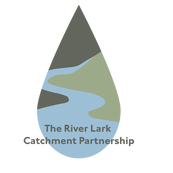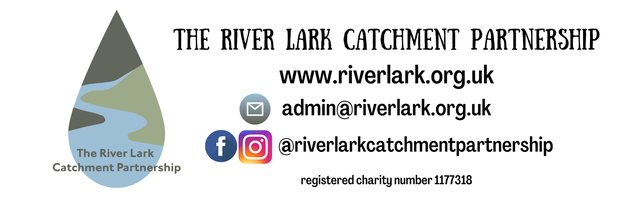River Lark Pollution Review and Action Plan
The River Lark Catchment Partnership (RLCP) is working with a range of stakeholders to take stock of the declining state of the main river, focusing on the Lark upstream of Bury St Edmunds, downstream to Mildenhall.
Like all rivers in the UK, the Lark is facing a number of pressures to the so-called ‘quality’ of the water. The chemical measurements of quality are a surrogate for the ability of that watercourse to sustain the life expected of it, based on ecotoxicity data derived in controlled laboratory tests. Of course, the complexity of water chemistry means that aquatic life is exposed to a range of chemical stressors simultaneously, and which will differ daily, and within and between years due to weather and human influences. Unravelling the specific stressor and how it is linked to the state of the river ecology is challenging, and more so when the stressors are dynamic, and come from multiple sources across a river catchment.
Building the picture to identify the critical stressors, and attribute to sources, and pathways and ultimately the organisms within a river is possible, using the monitoring data from reliable sources such as regulatory investigation programmes, discharge quality assessments, modelling and mapping tools. Biological data, however, – freshwater invertebrate (and fish) communities, diversity and abundance – integrates the true state of the water chemistry where habitat is not limiting their ability to live, grow reproduce. To understand the state of a river, it’s the organisms that live within it that hold the key.
Whilst undertaking chemical analysis reliably is a costly and highly technical activity, conducted largely by scientists with high-tech analysers, it is notable that biological data can be gathered and analysed by trained citizen scientists, and volunteers, who can provide essential evidence of change over time. In this case, the trigger for this assessment has come from data from the Riverfly Partnership, which has shown a clear decline in invertebrate communities, and with some evidence of the decline of fish populations in reaches known previously to hold wild, natural spawning brown trout (Salmo trutta). These findings were made following three hot summers and where rainfall was less than average, creating ‘environmental drought and prolonged dry weather’ conditions (Environment Agency) which extended through the period 2018-2021. The resulting low summer flows and high temperatures would appear to be related to this ecological decline.
These findings were shared with relevant local partners in the autumn of 2021, at the time of the completion of the latest round of water industry investment (Asset Management Planning round 7 – AMP7) and the environmental improvement programme, Water Industry National Environment Programme (WINEP). Following a meeting with the Member of parliament for the Constituency of Bury St Edmunds, Jo Churchill, the stakeholder group comprising the Environment Agency, Anglian Water, The Rivers Trust, Norfolk Rivers Trust and the Riverfly Partnership committed to work together to develop an evidence base, from which an action plan would be developed to reduce risks to the Lark catchment. This stakeholder group was to be led by the River Lark Catchment Partnership, with support from:
Critical to the review and assessment process was to identify all relevant pressures and treat them with balance. There has an initial focus on water quality and the main Anglian Water Water Recycling Centre (WRC) discharges, due to the timing of this review and the recent WINEP settlement. However, an equivalent amount of time has been devoted to diffuse rural and urban pollution to identify similarly the pressures, sources and impacts.
The review process has led to the development of two main outputs – a Catchment Appraisal (authored by Sam Hurst) and this report. The Catchment Appraisal will in effect be the basis for current evidence and be a living document into which new data will be added over time, to address both data gaps and maintain continuity with existing datasets.
This report on the River Lark Pollution Review and Action Plan is a snapshot of current and proposed interventions, and aims to set out a range of actions that the RLCP and its partners can take forward to reduce risks to the Lark, with the support of stakeholders. It is recommended that this report should have a life of two to three years where the actions should be reassessed in line with progress, environmental change, the development of the next water industry investment planning (PR24) and following the implementation of the much-anticipated Environmental Land Management Scheme (see recommendations)
The River Lark Catchment Partnership (RLCP) is working with a range of stakeholders to take stock of the declining state of the main river, focusing on the Lark upstream of Bury St Edmunds, downstream to Mildenhall.
Like all rivers in the UK, the Lark is facing a number of pressures to the so-called ‘quality’ of the water. The chemical measurements of quality are a surrogate for the ability of that watercourse to sustain the life expected of it, based on ecotoxicity data derived in controlled laboratory tests. Of course, the complexity of water chemistry means that aquatic life is exposed to a range of chemical stressors simultaneously, and which will differ daily, and within and between years due to weather and human influences. Unravelling the specific stressor and how it is linked to the state of the river ecology is challenging, and more so when the stressors are dynamic, and come from multiple sources across a river catchment.
Building the picture to identify the critical stressors, and attribute to sources, and pathways and ultimately the organisms within a river is possible, using the monitoring data from reliable sources such as regulatory investigation programmes, discharge quality assessments, modelling and mapping tools. Biological data, however, – freshwater invertebrate (and fish) communities, diversity and abundance – integrates the true state of the water chemistry where habitat is not limiting their ability to live, grow reproduce. To understand the state of a river, it’s the organisms that live within it that hold the key.
Whilst undertaking chemical analysis reliably is a costly and highly technical activity, conducted largely by scientists with high-tech analysers, it is notable that biological data can be gathered and analysed by trained citizen scientists, and volunteers, who can provide essential evidence of change over time. In this case, the trigger for this assessment has come from data from the Riverfly Partnership, which has shown a clear decline in invertebrate communities, and with some evidence of the decline of fish populations in reaches known previously to hold wild, natural spawning brown trout (Salmo trutta). These findings were made following three hot summers and where rainfall was less than average, creating ‘environmental drought and prolonged dry weather’ conditions (Environment Agency) which extended through the period 2018-2021. The resulting low summer flows and high temperatures would appear to be related to this ecological decline.
These findings were shared with relevant local partners in the autumn of 2021, at the time of the completion of the latest round of water industry investment (Asset Management Planning round 7 – AMP7) and the environmental improvement programme, Water Industry National Environment Programme (WINEP). Following a meeting with the Member of parliament for the Constituency of Bury St Edmunds, Jo Churchill, the stakeholder group comprising the Environment Agency, Anglian Water, The Rivers Trust, Norfolk Rivers Trust and the Riverfly Partnership committed to work together to develop an evidence base, from which an action plan would be developed to reduce risks to the Lark catchment. This stakeholder group was to be led by the River Lark Catchment Partnership, with support from:
- Anglian Water
- Environment Agency
- Natural England
- CamEO Catchment partnership
- Norfolk Rivers Trust
- The Riverfly Partnership, and
- The Rivers Trust
- Assess the current quality / state of the environment of the River Lark and its tributaries, against relevant benchmarks such as those set by Water Framework Directive and achieve Good Status
- Identify the critical pressures on the environment, using best available evidence, and identify critical data gaps
- Review the current regulatory measures and interventions being implemented to address the risks and pressures to the Lark catchment, and identify critical gaps in risk reduction measures necessary to achieve Good Status for the whole catchment.
- Develop actions, forming an Action Plan, that can deliver effective responses to reduce risks, and address the underlying pressures
- Inform relevant partners and stakeholders of the need for action, and enlist and gain commitment to deliver on those actions.
Critical to the review and assessment process was to identify all relevant pressures and treat them with balance. There has an initial focus on water quality and the main Anglian Water Water Recycling Centre (WRC) discharges, due to the timing of this review and the recent WINEP settlement. However, an equivalent amount of time has been devoted to diffuse rural and urban pollution to identify similarly the pressures, sources and impacts.
The review process has led to the development of two main outputs – a Catchment Appraisal (authored by Sam Hurst) and this report. The Catchment Appraisal will in effect be the basis for current evidence and be a living document into which new data will be added over time, to address both data gaps and maintain continuity with existing datasets.
This report on the River Lark Pollution Review and Action Plan is a snapshot of current and proposed interventions, and aims to set out a range of actions that the RLCP and its partners can take forward to reduce risks to the Lark, with the support of stakeholders. It is recommended that this report should have a life of two to three years where the actions should be reassessed in line with progress, environmental change, the development of the next water industry investment planning (PR24) and following the implementation of the much-anticipated Environmental Land Management Scheme (see recommendations)
| 2021-04_river_lark_pollution_review_and_action_plan_final_v1_april_2021__1_.pdf |

